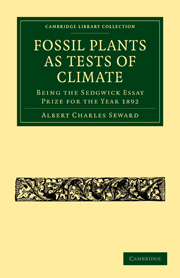Book contents
- Frontmatter
- PREFACE
- Contents
- Introduction
- Chapter I HISTORICAL SKETCH
- Chapter II PLANT DISTRIBUTION
- Chapter III PLANTS AND LOW TEMPERATURES: ARCTIC VEGETATION
- Chapter IV THE INFLUENCE OF EXTERNAL CONDITIONS UPON THE MACROSCOPIC AND MICROSCOPIC STRUCTURES OF PLANTS
- Chapter V ANNUAL RINGS IN RECENT AND FOSSIL PLANTS
- Chapter VI ARCTIC FOSSIL PLANTS
- Chapter VII CARBONIFEROUS PERIOD
- Chapter VIII PLEISTOCENE PLANTS AND CONCLUSION
- List of Works referred to in the Text
- Index
Chapter VIII - PLEISTOCENE PLANTS AND CONCLUSION
Published online by Cambridge University Press: 07 September 2010
- Frontmatter
- PREFACE
- Contents
- Introduction
- Chapter I HISTORICAL SKETCH
- Chapter II PLANT DISTRIBUTION
- Chapter III PLANTS AND LOW TEMPERATURES: ARCTIC VEGETATION
- Chapter IV THE INFLUENCE OF EXTERNAL CONDITIONS UPON THE MACROSCOPIC AND MICROSCOPIC STRUCTURES OF PLANTS
- Chapter V ANNUAL RINGS IN RECENT AND FOSSIL PLANTS
- Chapter VI ARCTIC FOSSIL PLANTS
- Chapter VII CARBONIFEROUS PERIOD
- Chapter VIII PLEISTOCENE PLANTS AND CONCLUSION
- List of Works referred to in the Text
- Index
Summary
A considerable amount of information upon Prehistoric floras is brought together by Mr Clement Reid in a paper in the Annals of Botany for 1888. Plants are recorded from the Cromer beds of Norfolk and from other deposits of different ages.
The different deposits may be roughly divided into Postglacial, Interglacial, and Preglacial.
The Cromer Forest bed (Upper Pliocene) has been fully described in Mr Reid's able Memoir on The Geology of the country around Cromer.
In the flora of this Preglacial deposit species occur which are no longer found in Britain, and which point to very Arctic conditions previous to the formation of the first boulder clay.
Of interglacial age we have the plant-bearing beds near Edinburgh. All the plants from the Redhall quarries (3 miles from Edinburgh) are still native in the Scotch lowlands except Galeopsis tetrahit and Carum carui: the flora of this age as a whole suggests a climate somewhat colder than that of the South of Scotland at the present day.
From the submerged forest and other beds of Postglacial age have been obtained a number of species still living in Britain.
A conveniently arranged list is given of the plants mentioned in Reid's paper by “H. B. W.” in the Geological Magazine for 1888, p. 567.
Since the publication of Clement Reid's summary in the Annals of Botany further additions have been made to our knowledge of Pleistocene vegetation in Britain.
- Type
- Chapter
- Information
- Fossil Plants as Tests of ClimateBeing the Sedgwick Essay Prize for the Year 1892, pp. 127 - 133Publisher: Cambridge University PressPrint publication year: 2009First published in: 1892



